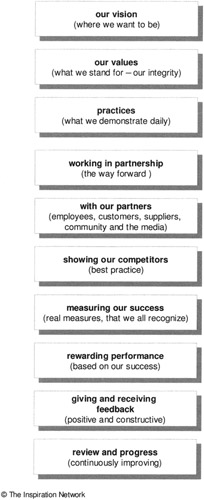Chapter 4: Organizational Change
In today's working environment everyone is having to recognize the need to embrace change. Change is everywhere. Having to work globally, virtually and in the face of new competition, leaders and individual workers are having to cope with new challenges daily. Helping people to cope with change and be flexible and resilient is an important part of any organization development and personal development strategy. Equally important is recognizing the need for organizations to embrace change within a context of constant improvement. Organizations and their management teams have responsibilities; they need to strive towards becoming employers of choice and taking a position of responsibility within their community. One way of doing this is to focus on developing an employer brand.
DEVELOPING AN EMPLOYER BRAND
'Branding' as a generic term is often assumed to belong to the marketing function. However increasingly organizations are waking up to the recognition that directly or indirectly most brand promises are delivered by people not products. Pick up any business magazine that talks about 'branding' and it is likely that it will be discussing the broader aspect of organizational, corporate or employer branding. There is also increasing emphasis on becoming an 'employer of choice'.
What is interesting is how this type of branding is defined. Terms like 'corporate branding', 'organizations as brands' and more recently 'employer branding' are different descriptors of basically the same process. What is clearly being recognized is that having strong consumer brands is not enough; organizations need to broaden their focus to consider other aspects such as:
-
people;
-
products/services;
-
processes/systems;
-
premises/environment.
'Branding' an organization means focusing on the key components and encouraging consistency across all functions. As with any piece of machinery, one part cannot operate without the other. Cross-functional working breaks down the traditional divisions between marketing, sales, distribution, manufacturing and HR.
The process links new service/product development and the development of employees . It links the distribution chain with the customer. It builds relationships not just agreements with external suppliers. It takes the most senior managers and involves them in the front line of the business. It puts customers in the centre and heart of the organization and builds everything else around them.
The organization doesn't just service its customers; they become its lifeblood. People do not just make promises, but they deliver, not once but over and over again, consistently developing better and better service. The organization differentiates itself in the market place through its people, its products, its processes and its premises.
In order to develop an employer /organization brand it is important to articulate the image and vision of the future and to invite all employees to unite behind it.
This 'branding' process normally has a number of components (see Figure 4.1). In practice this means identifying the following:
-
Our vision (where we want to be). This must be a real statement that people can easily remember and identify with, not just words on a wall.
-
Our values (what we stand for - our integrity). If these are not daily demonstrated behaviourally by everyone in the organization they are worthless.
-
Standards and practices (what we demonstrate daily). This is the way we do things, the way our performance is measured; it applies to everyone and ensures consistency.
-
Working in partnership (the way forward). No person or organization can function for long alone. Working with people, helping others to be successful, building pride and self-esteem and sharing success are all important components. Equally, building close links with suppliers, encouraging the media with positive news and building links with your local community are positive partnership actions.
-
Showing our competitors (best practice). Be proud of your achievements, and demonstrate best practice. Be the organization that others benchmark against. This will have internal spin-offs for morale .
-
Measuring our success (real measures, which everyone recognizes). Never forget where you started; realize how much progress has been made.
-
Rewarding performance (based on success). Not just money, but personal recognition, which is best demonstrated little and often.
-
Measuring performance (be realistic). Not 'We promise to do our best' but 'We promise to respond within 14 days, on time, and to meet identified standards.'
-
Giving and receiving feedback (positive and constructive). From the bottom to the top of the organization (and vice versa), open up channels of communication.
-
Review and progress (continuously improving). Ask 'What have we learnt?' and 'Where can we innovate?' To prevent a distorted view of the organization, the process should be seamless from the front to the back and from the top to the bottom of the organization.

Figure 4.1: Employer brand model
EAN: 2147483647
Pages: 94